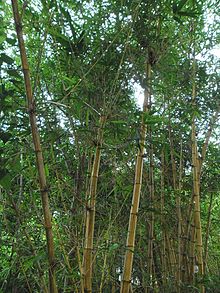
Bambusa vulgaris

Bambusa vulgaris, common bamboo, is an open-clump type bamboo species. It is native to Indochina and to the province of Yunnan in southern China, but it has been widely cultivated in many other places and has become naturalized in several. Among bamboo species, it is one of the largest and most easily recognized. Bambusa vulgaris forms moderately loose clumps and has no thorns. It has lemon-yellow culms (stems) with green stripes and dark green leaves. Stems are not straight, not easy to split, inflexible, thick-walled, and initially strong. The densely tufted culms grow 10–20 m (30–70 ft) high and 4–10 cm (2–4 in) thick. Culms are basally straight or flexuose (bent alternately in different directions), drooping at the tips. Culm walls are slightly thick.Nodes are slightly inflated. Internodes are 20–45 cm (7.9–17.7 in). Several branches develop from mid-culm nodes and above. Culm leaves are deciduous with dense pubescence. Leaf blades are narrowly lanceolate. Flowering is not common, and there are no seeds. Fruits are rare due to low pollen viability caused by irregular meiosis. At the interval of several decades, the whole population of an area blooms at once, and individual stems bear a large number of flowers. Vegetation propagates through clump division, by rhizome, stem and branch cutting, layering, and marcotting. The easiest and most practised cultivation method is culm or branch cutting. In the Philippines, the best results were obtained from one-node cuttings from the lower parts of six-month-old culms. When a stem dies, the clump usually survives. A clump can grow out of stem used for poles, fences, props, stakes, or posts. Its rhizomes extend up to 80 cm before turning upward to create open, fast-spreading clumps. The easy propagation of B. vulgaris explains its seemingly wild occurrence. The average chemical composition is cellulose 41–44%, pentosans 21–23%, lignin 26–28%, ash 1.7–1.9%, and silica 0.6–0.7%. The bambusoid taxa have long been considered the most 'primitive' grasses, mostly because of the presence of bracts, indeterminate inflorescences, pseudospikelets (units of inflorescence or flower clusters and glumes or leaf-like structures in woody bamboos that is similar to spikelets or clumps of grass), and flowers with three lodicules (tiny scale-like structure at the bottom of a florets or clump of grass flowers, found between lemma, the lowest part of spikelets, and sexual organs of the flower), six stamens, and three stigmas. Bamboos are some of the fastest growing plants in the world. B. vulgaris is a species of the large genus Bambusa of the clumping bamboo tribe Bambuseae, which are found largely in tropical and subtropical areas of Asia, especially in the wet tropics. The pachymorph (sympodial or superposed in such a way as to imitate a simple axis) rhizome system of clumping bamboos expands horizontally by only a short distance each year. The shoots emerge in a tight or open habit (group), depending on the species; common bamboo has open groups. Regardless of the degree of openness of each species' clumping habit, none of the clumpers are considered invasive. New culms can only form at the very tip of the rhizome. The Bambuseae are a group of perennial evergreens in subfamily Bambusoideae, characterized by having three stigmata and tree-like behavior, that are in turn of the true grass family Poaceae. At least three groupings of B. vulgaris cultivars can be distinguished: The more common cultivars are:
